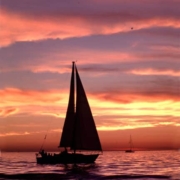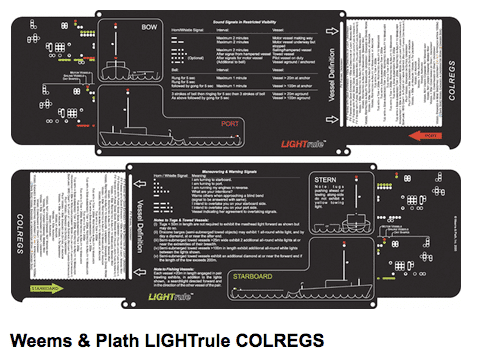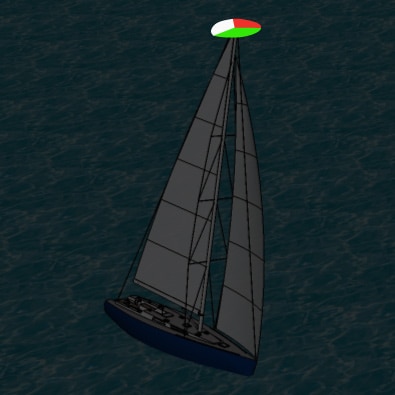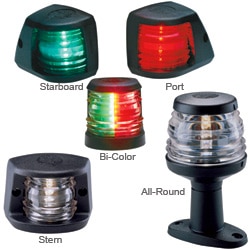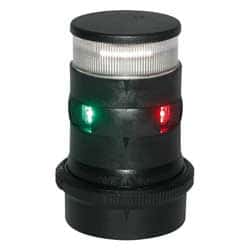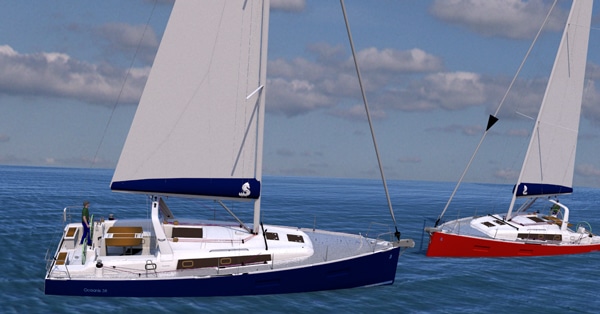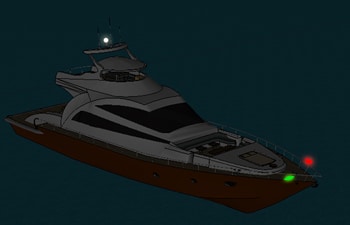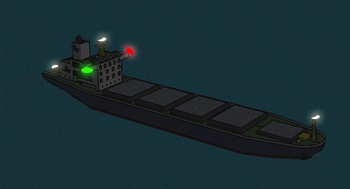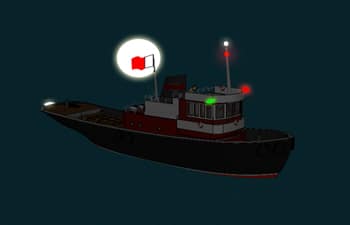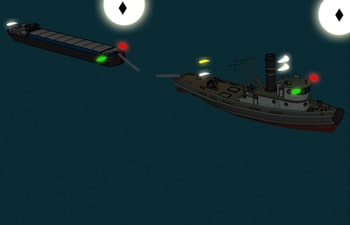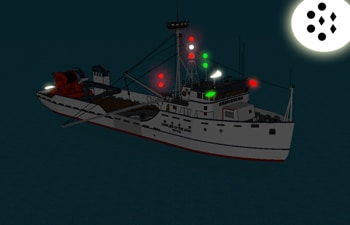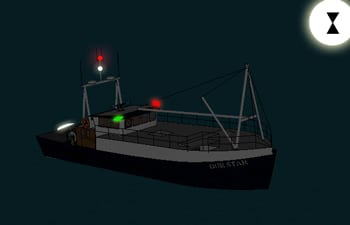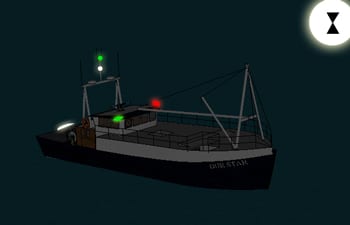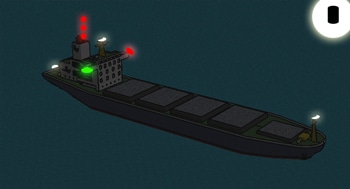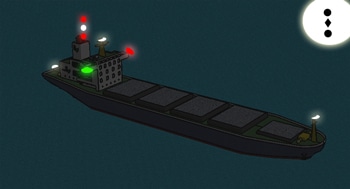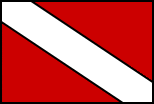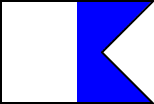Vessel Lights and Shapes
Nighttime can be a beautiful time to sail. However, night vision is not the same as day vision and so rules have been established to ensure safety. Regardless of visibility, due to nighttime, fog or cloudy conditions, garish distracting city lights, or clear romantic moonlit skies, sailors need to know their colors.
Powerboats, large shipping vessels, and vessels at anchor will display a variety of lights, some steady and some flashing at regular intervals. All of these are providing essential information to help avoid collisions.
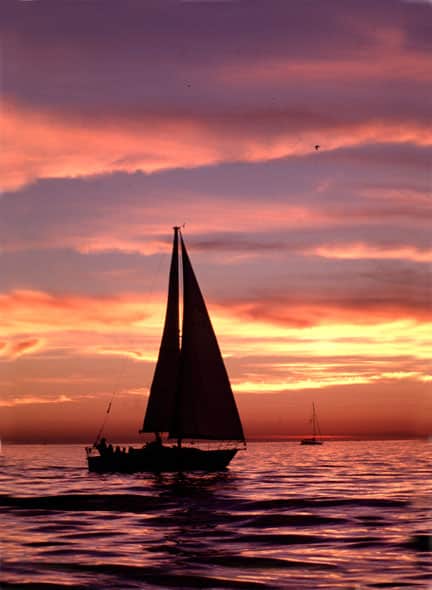
Photo Courtesy of Bob Grieser
Night Sailing Requirements (and Day Shapes)
Your responsibility, when sailing in diminished lighting conditions and after sunset and before sunrise is to turn your navigation lights on. Don’t assume they are working – the sea salt environment is a poor environment to expect electrical contact to continuously work. Visually check for operation after you turn them on.
All vessel types have a unique distinguishing set of lights that they must adhere to depending on the type of vessel. i.e. Sailing, towing, fishing, restricted in ability to maneuver, constrained by draft, dredging, etc. It would be prudent for you to learn all the differences in these lights – hint some are on the test. However, there are Apps, lookup charts, and tools that you can stow on board so that you don’t have to rely on 100% functionality of your brain cells.
Reference Tools
A good tool by Weems and Plath is the light slide rule available at
https://www.landfallnavigation.com/w-p-lightrule-colregs.html
You simply slide the card in its sleeve until you see the matching set of lights to your observed vessel.
Apps
There are also good Apps available. You should download one now – you never know when you will need it.
Here is one for iOS
ColRegs: Nav Lights & Shapes for Boating and Sailing
Or for Android
https://play.google.com/store/apps/details?id=com.imar.nav3d
On The Web
The lights for all vessels are covered in the Navigation Rules printed by the USGC and apply to international rules as well. They are Part C Rules 20 through 31.
You can get the latest version in book format from amazon.com. Or download the Kindle App to your smartphone and get the Kindle book version of the rules also from Amazon.
The Rules for Vessels
For sailing vessels the lights required internationally are
- Bow – red (port side) and green (starboard side) with a 112.5 degrees arc – remember “is there any red port left”
- Anchor Light – white 360 degrees at the top of the mast (for anchored only)
- Mast head – white 225 degrees facing forward (for under power only sometimes called a steaming light)
- Stern – white with a 135 degrees arc
- Optional – Masthead 360 degrees red over green in addition to the lights on the bow and stern
Rule 25 also allows for the combining of the lights.
b) In a sailing vessel of less than 20 meters in length the lights prescribed in Rule 25(a) may be combined in one lantern carried at or near the top of the mast where it can best be seen.
This is sometimes referred to as a tri-colored light. Note that it is a replacement for the bow and stern lights not “in addition to”.
Here are some examples of actual lights to be mounted on vessels:
Individual red and green or Bi-Color to mount on forward bow rail plus a white stern light and all-around white. Note that angles are preset into the light housings.
Tricolor for the top of mast combining an all-around white anchor light. The back side of this housing will contain a 135-degree shining white light. The red and green angles will start from directly ahead and then arcing 112 degrees back on their respective sides.
When sailing at night and meeting another vessel (that you do not want to hit) remember that your starboard light is green and your port light is red. The same as the lights of the oncoming vessel.
When meeting head-on, the color light on your vessel will pass the approaching vessel’s same color light. For example, if you are passing starboard to starboard (the starboard side of your vessel will see the starboard side of the other vessel) your green light will meet the green light on the other vessel. Or you may pass port to port (red light to red light). If you see red and green on the other vessel, they are heading directly at you. When in a head-on situation, and you are the Stand On vessel, it is at your discretion as to whether you pass port to port or starboard to starboard and the decision will be dependent upon the conditions. When in a head-on situation, powerboats typically pass port to port. Thus it is prudent that a sailboat do the same if practical. Make your turn large and obvious for the other boat to recognize your new direction.
At night the danger is heightened because distances are hard to determine. Therefore, a keen lookout is required and actions must be taken early. Determine who is the stand-on (right of way) vessel and make any course changes you perform obvious and unambiguous. Hail on VHF, hail aloud, use a sound device whatever it takes to ensure you are avoiding collision. Two short blasts mean passing starboard to starboard sides. One short blast means passing port to port sides.
A good rule of thumb to use once you spot a light is to first ascertain which side of the other vessel you see via the color of the light. Then watch the bearing of that light relative to your vessel. If the bearing is unchanging, then you are likely on a collision course.
Sailboats Under Power
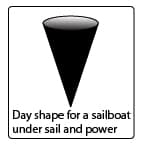
In reality, few recreational sailors display this shape even if required. i.e. don’t rely on seeing this shape when making giveway decisions; but, if you are under power with your sails up, we recommend hoisting this shape.
In the image below the vessel on starboard (red) must giveway because it is under power. We can not be sure if Blue is under power or not. However, the skipper of red must make the assumption that blue is fully under sail and therefore MUST give way.
Other Vessels
Where required, the “By Day” shapes are shown in the white circles.
Power Vessels (less than 50m) One all-around white plus red and green.
Large Power Ships over 50 m
Same for Power Vessels except for the addition of a forward-facing mast light. In addition, in general, for all power boats below, any time you go over 50m in length you need to add another forward-facing mast light.
What you have to be cognizant of is being able to imagine what this looks like at night.
For example, the container ship bearing down on you in pitch dark with look like this below. We certainly hope that you never see this.
Towing
Two forward-facing white lights plus yellow aft
Dredging or cable laying – underwater operations
All around red over white over red. Plus two red on the danger side, and two green on the non-danger side.
Fishing with a long line
Commercial fishing operation with a line. Red over white.
Fishing with nets etc – trawling
Commercial fishing operation with a net. Green over white.
Constrained by Draft
Three Red
Restricted in Ability to Maneuver
Red over white over red
Diving
Two ‘diver down’ flags that you need to be aware of to indicate that this vessel has scuba divers below. You are required to stay 100 meters away from such a vessel.
In the USA the red flag with a white strip is used
In most of the rest of the world, the Code A flag is used


